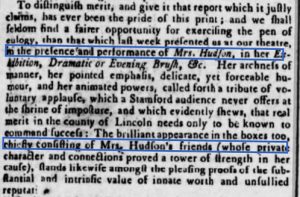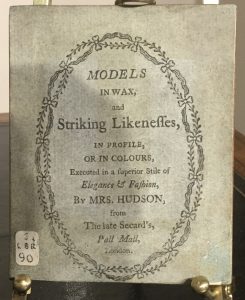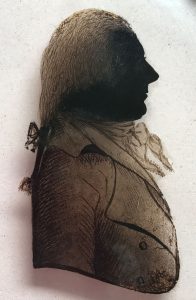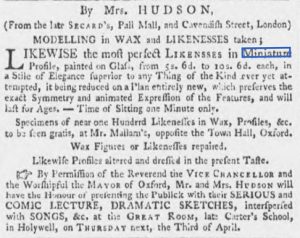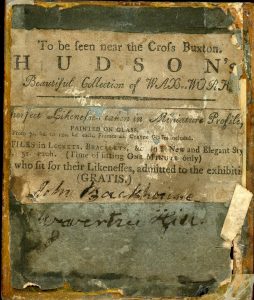Mrs Hudson – A Lady of Many Parts
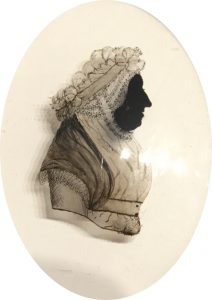 The discovery of hitherto unknown newspaper advertisements placed by Mrs Hudson between 1779 and 1802 has revealed the diversity of her career.
The discovery of hitherto unknown newspaper advertisements placed by Mrs Hudson between 1779 and 1802 has revealed the diversity of her career.
Born in Bath in 1753, Elizabeth was the first child of Henry and Ann Chilcot. Her sisters, Harriet and Ann, were born in 1754 and 1755 respectively. Their father (bap. 1730) was apprenticed to a jeweller and goldsmith before being taken on as a ‘principal workman’ for James Bellis, jeweller and toyman of Pall Mall.
By 1773 Henry Chilcot had his own jewellery business that he advertised in the Bath Chronicle. What set his business apart from his rivals was the ‘inimitable hair work’ offered courtesy of his daughter, Elizabeth. Accomplished in the art, Elizabeth created portraits and landscapes in chopped hair as well as pieces with urns, altars and trees for mourning miniatures. The adverts proclaimed her ‘a genius far superior to any who ever yet attempted that ingenious art’. Given the proliferation of miniature painters working in Bath at that time, Elizabeth would not have been short of work.
It was previously believed that Elizabeth’s mother was the Mrs Chilcot who ran a boarding school for young ladies but this was actually her aunt by marriage. Her mother, Ann Chilcot, died in 1775 and was buried in Bath Abbey ‘near ye Pillar at end of ye Charity School Girls Seat’. Her father’s death has not been traced but he possibly died in 1777, the latest advert for his jewellery shop having appeared in December 1776.
On 7 October 1777 Elizabeth Chilcot married William Hudson of a neighbouring parish by special license obtained that same day with a bond of £200. Given that Elizabeth was 24 years old, the license may have been required for expediency if she was pregnant. Alternatively her family may have opposed the marriage or there may have been a large age gap between the couple. Significantly the marriage was not witnessed by either family but by John Dover, a local innkeeper, and his mother. On the licence application William gave his occupation as ‘apothecary & surgeon’ yet no record of him working in that profession has been traced. Indeed no biographical details for William Hudson can be verified whilst later evidence suggests his occupation may have been quite different.
The newly weds’ immediate movements are obscure. Mrs Hudson’s first known advert appeared two years later in Aris’s Birmingham Gazette (23 September 1779) when ‘Mrs Hudson (late Miss Chilcot) from Bath’ is offering ‘striking likenesses’ in the sitter’s own hair that are ‘superior to those in colours’. What prompted her return to hair work is unclear. If her husband truly was an apothecary-surgeon there should have been no need for her to work. No further adverts have been traced until January 1882 when she has returned to Birmingham from having created ‘upwards of sixty’ likenesses in hair over four months spent in Gloucester. By February 1783 she has ventured to Oxford before moving on to Reading and Winchester. The following Spring she is offering her hair work in Gosport and Portsmouth.
Around this time Mrs Hudson’s career took a surprising turn as in 1787 she appeared on stage alongside a Mrs Gibbs in a short piece entitled ‘Muses in Motion’ at the Royalty Theatre in Wellclose Square, Whitechapel. Opened in 1787, the Royalty Theatre could accommodate an audience of 2,594 so it would have taken a lot of self-confidence to have performed there especially as a debut. The General Magazine were not enamoured of her performance but when she returned in September with ‘Sketches from Nature, or, Beaux and Belles Have at Ye’ they praised her ‘genius and animation’ in what was ‘an elegant and lively trifle’. The review went on to applaud Mrs Hudson’s good domestic character and claimed that ‘the benefit of her husband led her again to the stage’. This surely suggests that Mr Hudson was a thespian and not an apothecary-surgeon and that it was his influence that led Mrs Hudson to her new career.
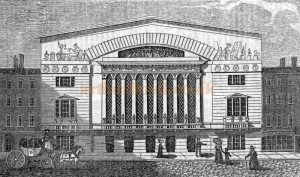
The Royal Brunswick Theatre, Wellclose Square which replaced the Royalty Theatre in 1828 after it burned down (The Mirror, 1828).
In late 1789, Mrs Hudson was on tour in Herefordshire with a new routine, ‘Exhibition, Dramatic Brush &c’. According to the Hereford Journal (18 November 1789), Mrs Hudson played to a crowded house with a ‘witty and pointed’ lecture delivered with ‘genius and animation’ with ‘excellent’ songs, ‘good poetry and music’. No mention is made of Mr Hudson so it may have been a one-woman show.
Between October 1789 and September 1791, Mrs Hudson continued to tour the provinces with her ‘Exhibition & Dramatic Brush’ with the addition of a popular new sketch, ‘Royal Procession to St Paul’s’, in celebration of the King’s recovery and his going to St Paul’s on St George’s Day. The performance now included songs by Mr Hudson. Following upwards of 50 nights at the Royalty Theatre they performed in Worcester, Monmouth, Hereford, Gloucester, Cheltenham, Nottingham, Derby, Lincoln and Stamford sometimes to coincide with a Race Meet or an annual Mart. The Stamford Mercury (22 October 1790) gave Mrs Hudson a glowing review –
Between September 1791 and May 1793, no advertisements have been traced so this appears to be the period when she was engaged by Secard’s Gallery in London. Lewis Secard was a well-known picture dealer with a gallery on Pall Mall where, in addition to his art dealing, he liked to hold exhibitions and entertainments. He advertised, for instance, an intriguing show of ‘Philosophical Fireworks (produced from inflammable air)’ to be accompanied by a performance on musical glasses! Perhaps Mrs Hudson was talent-spotted by Secard and invited to perform her ‘Exhibition’ at his gallery. Being surrounded by fine art may have been the prompt for her to try her hand at painting profiles for the first time and to experiment with wax modelling.
Lewis Secard died suddenly in March 1793; the following month Elizabeth Hudson was back on the road with her ‘Exhibition’. But now she had new skills and for the first time, advertising herself as ‘Mrs Hudson (from the late Secard’s Pall-Mall, and Cavendish Street)’, she offered wax modelling and ‘likenesses in miniature profile painted on glass’ (Oxford Journal, 29 March 1794). Proud of her association with Secard’s Gallery she commissioned her first trade label.
It was the Oxford advert that proved beyond doubt that the performing Mrs Hudson and the silhouette artist were one and the same person –
Over the next couple of years Mrs Hudson added wax modelling, colour miniatures on ivory and profiles for bracelets and lockets to her repertoire. Significantly in 1796 she was joined in her art business by her son. His details though remain obscure.
In 1797 the business took a new turn when Mr and Mrs Hudson ‘from the theatres, London and last of Cambridge’ appeared for one night only at the Theatre Royal in Manchester with ‘As You Like It, or, A Laughable Exhibition’ that included an address by Mrs Hudson with songs by her husband and a selection from Mr Collins’s* ‘Evening Brush’. Afterwards Mrs Hudson was to ‘draw the pictures of the audience . . . in such a style that the outlines shall not offend nor the colouring afford a shadow of disgust’. It’s difficult to see how this would have worked in a large and crowded theatre but it was certainly a novel way to engage with the audience.
This is the last known advert for Mr and Mrs Hudson’s theatrical career; perhaps Mr Hudson died around this time. Now in her mid-forties, Mrs Hudson moved to Liverpool where, from 1798, she and her son continued to offer wax modelling as well as likenesses in miniature and miniature profile in a ‘new and elegant style’ from Paradise Street with the enticing strapline – ‘the tide of fashion still flows towards their habitation’. Centrally located, Paradise Street was indeed a desirable address though not their only one as the Hudsons also had a house in Christleton near Chester where specimens of their work could be viewed.
But Elizabeth Hudson was not quite ready to disappear into retirement and had one last surprising venture to try: 21 July 1802 was the proposed opening date for Mrs Hudson’s School for young ladies. Based at her home in Christleton, she planned to have twelve boarders who, for 18 Guineas a year, would be taught English grammar and needlework. Writing, accounts, music, French and dancing were offered as extras. It’s not known whether her venture came to fruition as no further adverts for her school have been traced.
Regrettably Mrs Hudson’s trail goes cold at this point. No record of her death or burial can be found. Just as Mr Hudson disappeared, so too does Elizabeth and her son. Nor can any information be found to link her to the C.H. Hudson who was painting charming silhouettes on glass between 1811 and 1821 in the Bath/Cirencester area.
*Mr Collins, author of ‘Evening Brush’ was married to Mrs Collins, the silhouette artist but that’s a whole other story!
